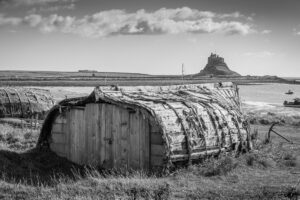Mining the Diaries 93: England
Marram Cottage, Beadnell, Northumberland, 11th September 2019
We decided to go to Lindisfarne today, checked the times for access across the causeway (5.30 mam – 12.30pm) and set off promptly after breakfast, driving through Seahouses, Bamburgh and Belford then on to Beal. Suddenly we swapped the trees and hedges of green countryside for the Holy Island Sands – a humbling open vista of sand and salt marsh backed by dunes where the bubbling call of curlew carried on the wind.
We left the car in the nearly empty car park and walked up towards Lindisfarne Castle in dazzling sun. A stiff breeze whipped up white horses in the harbour. At the turn of the 20th Century the castle was no more than the ruins of a 16th century fort with gun emplacements perched high on a crag. Edward Hudson, owner of Country Life bought it in 1902 and commissioned Sir Edwin Lutyens to turn it into the romantic, idealized castle of today. To the north of it, across rough pasture, the Gertrude Jekyll Garden sheltered in a small stone enclosure. Once a vegetable plot for soldiers stationed there, it was turned into a formal garden when Lutyens converted the castle – Lutyens and Jekyll were regular collaborators. The main colour palette of the garden was yellow, with a glowing bed of red sedum at its heart; it smelt faintly of roses and sweet peas.
We continued down towards the shore and looped round towards the castle, past a stream of figures trudging up the track from the village (it’s a National Trust property). Near the harbour the upturned hulls of old herring boats were used by fishermen as sheds for their nets and tools; unwilling to send their old boats to the breakers, they made clever use of the materials they had to hand. We headed into the village following the aroma of roasting coffee to the Pilgrim’s Café.
The village was charming and appeared quite unspoilt. The Priory Church was a glorious ruin in dark red weathered stone. As we stood outside admiring the chevron arches as a proud father was photographing his daughter by the door; we stepped aside, he said, ‘Thank you. We’ve just walked from Melrose’ (around 50 miles). We sat in the nearby late 13th Century church of St Mary, at first gloomy with its widely spaced lancet windows, but revealing itself as eyes became accustomed to the dark. The lines of old arches and roofs showed how it has been changed over the years from its 12th century origins. A modern window depicted eider, puffin, seals, the causeway and the upturned boats. Nearby stood the rugged Journey, a wooden sculpture, carved from seven elm trees, by Fenwick Lawson in 1999. It depicted the monks of Holy Island carrying the coffin of St. Cuthbert to safety and eventual rest in Durham Cathedral, when Viking raiders threatened the island around 875 AD.

